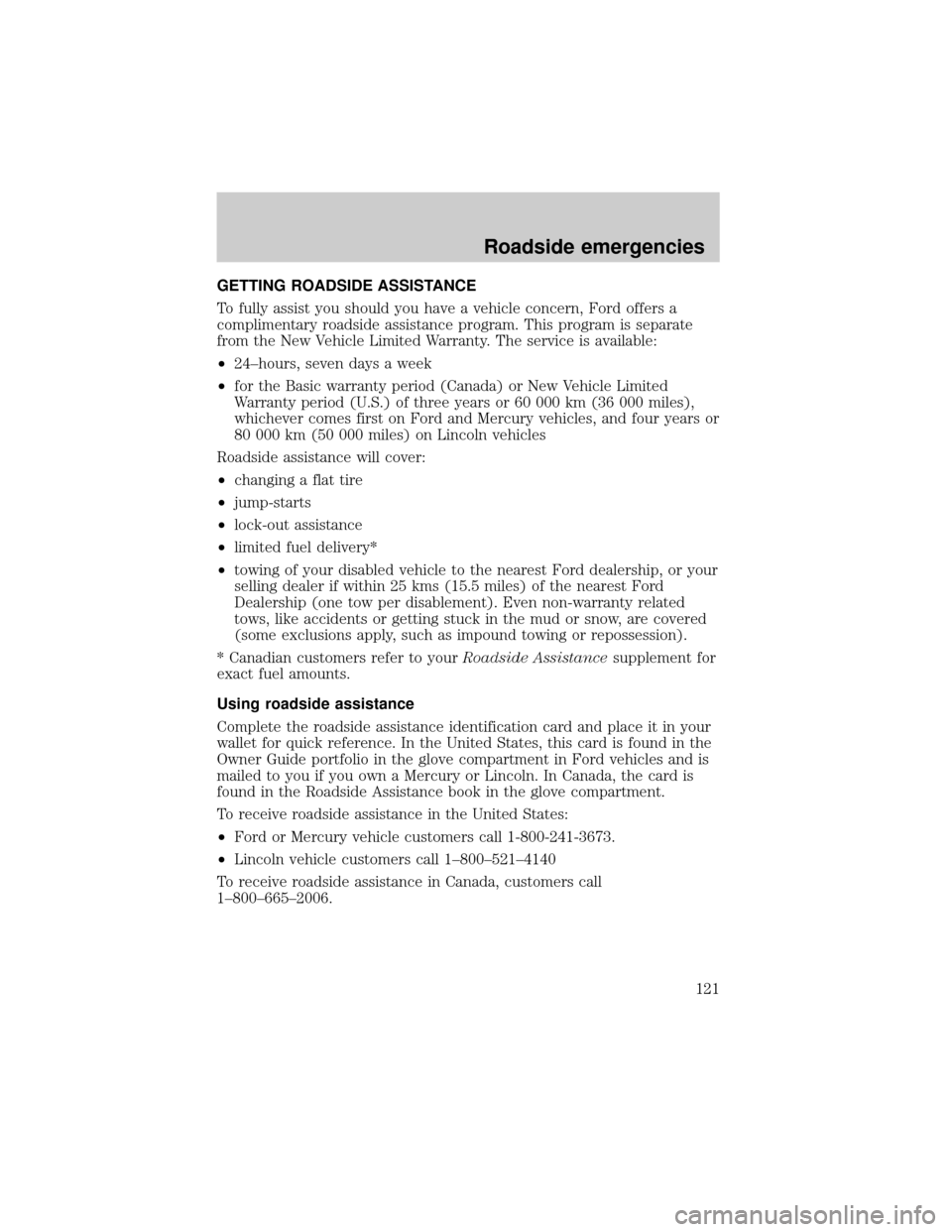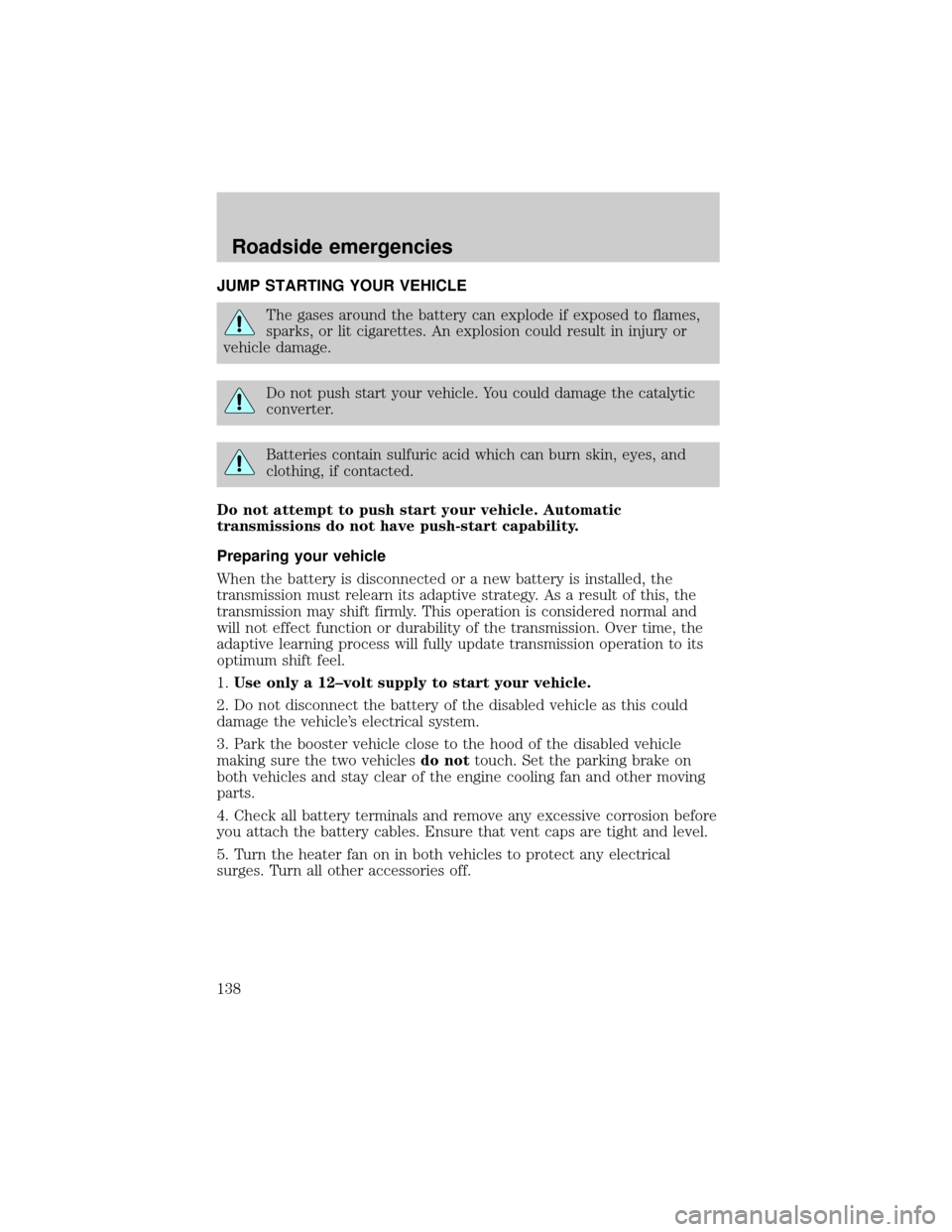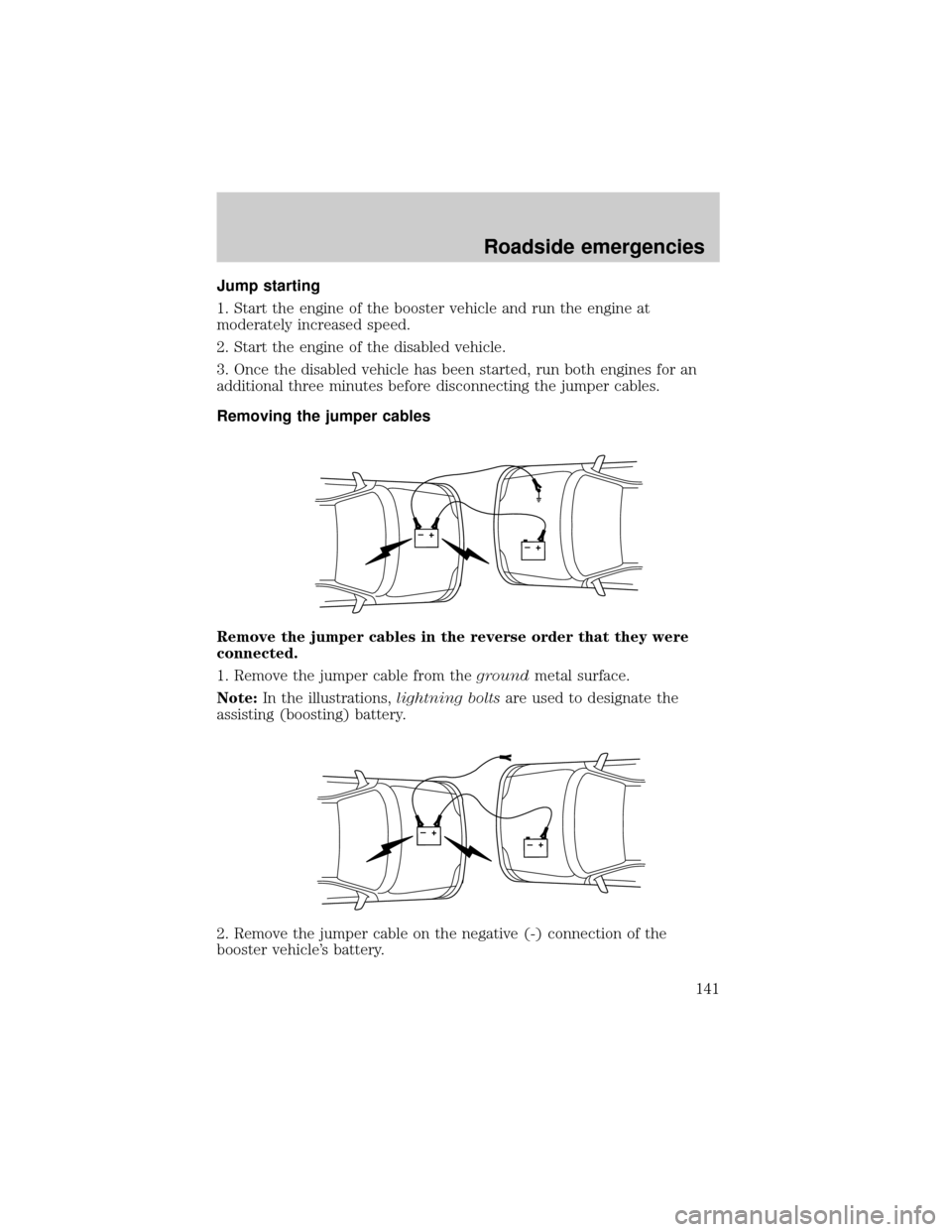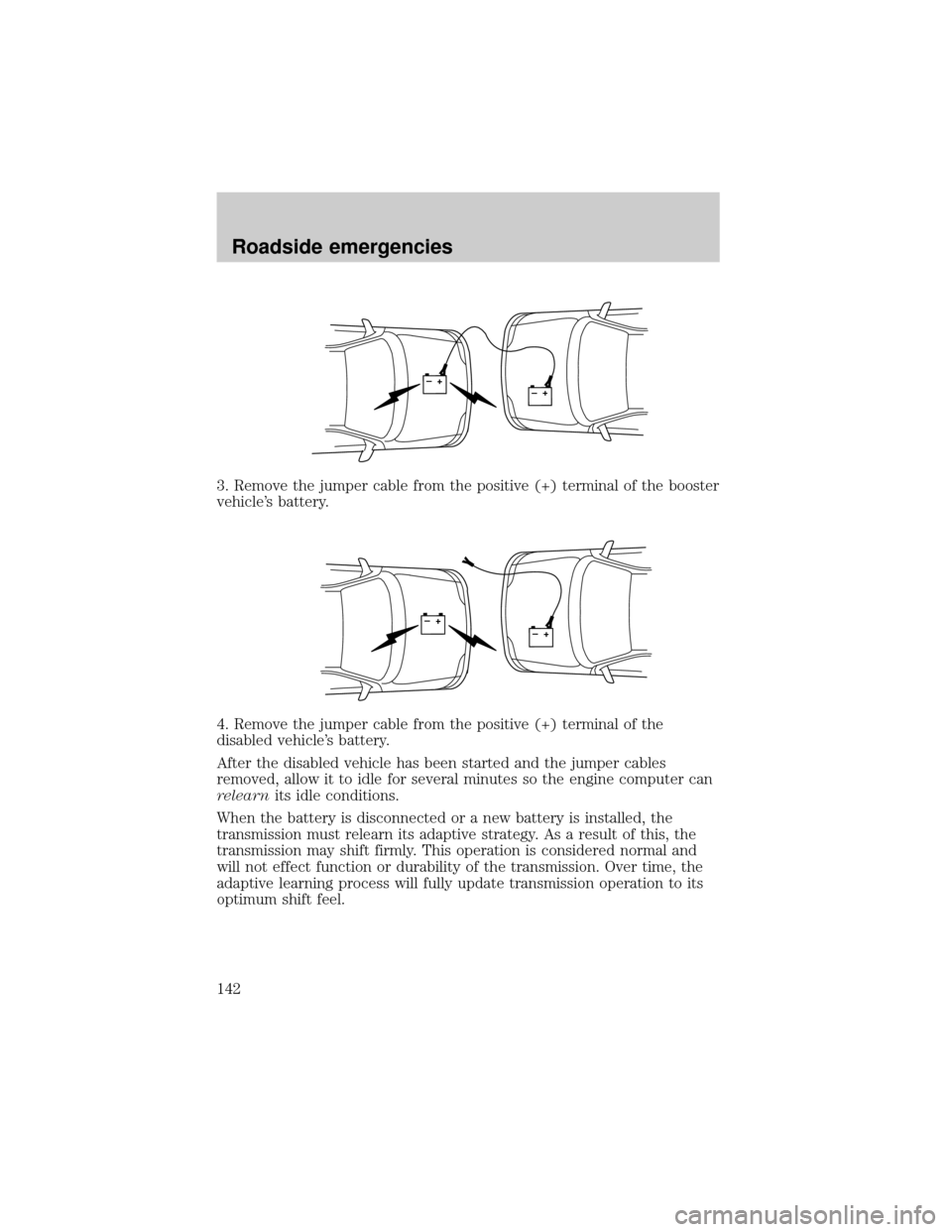jump start FORD E SERIES 2001 4.G Owners Manual
[x] Cancel search | Manufacturer: FORD, Model Year: 2001, Model line: E SERIES, Model: FORD E SERIES 2001 4.GPages: 224, PDF Size: 1.82 MB
Page 121 of 224

GETTING ROADSIDE ASSISTANCE
To fully assist you should you have a vehicle concern, Ford offers a
complimentary roadside assistance program. This program is separate
from the New Vehicle Limited Warranty. The service is available:
²24±hours, seven days a week
²for the Basic warranty period (Canada) or New Vehicle Limited
Warranty period (U.S.) of three years or 60 000 km (36 000 miles),
whichever comes first on Ford and Mercury vehicles, and four years or
80 000 km (50 000 miles) on Lincoln vehicles
Roadside assistance will cover:
²changing a flat tire
²jump-starts
²lock-out assistance
²limited fuel delivery*
²towing of your disabled vehicle to the nearest Ford dealership, or your
selling dealer if within 25 kms (15.5 miles) of the nearest Ford
Dealership (one tow per disablement). Even non-warranty related
tows, like accidents or getting stuck in the mud or snow, are covered
(some exclusions apply, such as impound towing or repossession).
* Canadian customers refer to yourRoadside Assistancesupplement for
exact fuel amounts.
Using roadside assistance
Complete the roadside assistance identification card and place it in your
wallet for quick reference. In the United States, this card is found in the
Owner Guide portfolio in the glove compartment in Ford vehicles and is
mailed to you if you own a Mercury or Lincoln. In Canada, the card is
found in the Roadside Assistance book in the glove compartment.
To receive roadside assistance in the United States:
²Ford or Mercury vehicle customers call 1-800-241-3673.
²Lincoln vehicle customers call 1±800±521±4140
To receive roadside assistance in Canada, customers call
1±800±665±2006.
Roadside emergencies
121
Page 138 of 224

JUMP STARTING YOUR VEHICLE
The gases around the battery can explode if exposed to flames,
sparks, or lit cigarettes. An explosion could result in injury or
vehicle damage.
Do not push start your vehicle. You could damage the catalytic
converter.
Batteries contain sulfuric acid which can burn skin, eyes, and
clothing, if contacted.
Do not attempt to push start your vehicle. Automatic
transmissions do not have push-start capability.
Preparing your vehicle
When the battery is disconnected or a new battery is installed, the
transmission must relearn its adaptive strategy. As a result of this, the
transmission may shift firmly. This operation is considered normal and
will not effect function or durability of the transmission. Over time, the
adaptive learning process will fully update transmission operation to its
optimum shift feel.
1.Use only a 12±volt supply to start your vehicle.
2. Do not disconnect the battery of the disabled vehicle as this could
damage the vehicle's electrical system.
3. Park the booster vehicle close to the hood of the disabled vehicle
making sure the two vehiclesdo nottouch. Set the parking brake on
both vehicles and stay clear of the engine cooling fan and other moving
parts.
4. Check all battery terminals and remove any excessive corrosion before
you attach the battery cables. Ensure that vent caps are tight and level.
5. Turn the heater fan on in both vehicles to protect any electrical
surges. Turn all other accessories off.
Roadside emergencies
138
Page 141 of 224

Jump starting
1. Start the engine of the booster vehicle and run the engine at
moderately increased speed.
2. Start the engine of the disabled vehicle.
3. Once the disabled vehicle has been started, run both engines for an
additional three minutes before disconnecting the jumper cables.
Removing the jumper cables
Remove the jumper cables in the reverse order that they were
connected.
1. Remove the jumper cable from thegroundmetal surface.
Note:In the illustrations,lightning boltsare used to designate the
assisting (boosting) battery.
2. Remove the jumper cable on the negative (-) connection of the
booster vehicle's battery.
+–+–
+–+–
Roadside emergencies
141
Page 142 of 224

3. Remove the jumper cable from the positive (+) terminal of the booster
vehicle's battery.
4. Remove the jumper cable from the positive (+) terminal of the
disabled vehicle's battery.
After the disabled vehicle has been started and the jumper cables
removed, allow it to idle for several minutes so the engine computer can
relearnits idle conditions.
When the battery is disconnected or a new battery is installed, the
transmission must relearn its adaptive strategy. As a result of this, the
transmission may shift firmly. This operation is considered normal and
will not effect function or durability of the transmission. Over time, the
adaptive learning process will fully update transmission operation to its
optimum shift feel.
+–+–
+–+–
Roadside emergencies
142
Page 217 of 224

wheels ......................................189
windows ..................................191
wiper blades ............................190
Climate control (see Air
conditioning or Heating) ............19
Clock ................................30, 37, 46
Compass, electronic ....................57
calibration .................................59
set zone adjustment .................58
Console
overhead ....................................56
Controls
power seat .................................67
Coolant
checking and adding ..............151
refill capacities ................155, 193
specifications ..................196, 199
Cruise control
(see Speed control) ....................50
Customer Assistance ................121
Ford accessories
for your vehicle ......................210
Ford Extended
Service Plan ............................203
Getting assistance outside
the U.S. and Canada ..............209
Getting roadside assistance ...121
Getting the
service you need ....................203
Ordering additional
owner's literature ...................214
The Dispute
Settlement Board ...................206
Utilizing the Mediation/
Arbitration Program ...............209D
Daytime running lamps
(see Lamps) ................................18
Dipstick
automatic
transmission fluid ...................158
engine oil .................................146
Doors
lubricant specifications ..........196
Driveline universal joint
and slip yoke .............................160
Driving under special
conditions
through water .........................120
E
Emergencies, roadside
jump-starting ..........................138
Emission control system ..........180
Engine ........................................199
check engine/
service engine soon light .........10
cleaning ...................................189
coolant .....................................151
diesel ...........................................5
fail-safe coolant ......................156
idle speed control ...................161
lubrication
specifications ..................196, 199
refill capacities ........................193
service points ..........................146
starting after a collision .........122
Engine block heater .................100
Engine oil ..................................146
checking and adding ..............146
dipstick ....................................146
filter, specifications ........148, 192
Index
217
Page 219 of 224

Hood ..........................................145
I
Ignition .................................49, 199
Infant seats (see Safety seats) ..89
Inspection/maintenance
(I/M) testing ..............................181
Instrument panel
cleaning ...................................190
cluster ................................10, 191
lighting up
panel and interior .....................19
location of components ............10
J
Jack ............................................131
positioning ...............................131
storage .....................................131
Jump-starting your vehicle ......138
K
Keys
key in ignition chime ...............14
positions of the ignition ...........49
L
Lamps
bulb replacement
specifications chart ................186
cargo lamps ...............................19
daytime running light ...............18
headlamps .................................18
headlamps, flash to pass ..........19
instrument panel, dimming .....19
interior lamps .....................59±60
replacing bulbs ...............182±186Lane change indicator
(see Turn signal) ........................50
Lights, warning and indicator ....10
air bag ........................................12
anti-lock brakes (ABS) ....10, 102
brake ..........................................10
charging system ........................12
check coolant ............................13
engine oil pressure ...................13
high beam .................................13
safety belt .................................12
service engine soon ..................10
turn signal indicator .................13
Load limits .................................109
GAWR ......................................109
GVWR ......................................109
trailer towing ..........................109
Loading instructions .................111
Lubricant specifications ...196, 199
Lumbar support, seats ...............68
M
Mirrors
fold away ...................................62
side view mirrors (power) .......61
Motorcraft parts ................176, 192
O
Octane rating ............................174
Odometer .....................................16
Oil (see Engine oil) ..................146
Overdrive .....................................55
Index
219
Page 220 of 224

P
Panic alarm feature, remote
entry system ................................63
Parking brake ............................103
Parts (see Motorcraft parts) ....192
Power distribution box
(see Fuses) ...............................128
Power door locks ........................61
Power steering ..........................104
fluid, checking and adding ....157
fluid, refill capacity ................193
fluid, specifications .........196, 199
Preparing to
drive your vehicle .....................105
R
Radio ............................................27
Relays ................................124, 131
Remote entry system ...........62±63
illuminated entry ......................65
locking/unlocking doors ...........63
panic alarm ...............................63
replacement/additional
transmitters ...............................65
replacing the batteries .............64
S
Safety belts (see
Safety restraints) ............14, 73±77
Safety defects, reporting ..........215
Safety restraints ....................73±77
belt minder ...............................79
cleaning the safety belts ..82, 191
extension assembly ..................78
for adults .............................74±76for children .........................87±88
lap belt ......................................78
warning light
and chime ......................12±13, 79
Safety seats for children ............89
Seat belts
(see Safety restraints) ...............73
Seats ............................................66
child safety seats ......................89
Servicing your vehicle ..............144
Spark plugs,
specifications .....................192, 199
Special notice ................................4
ambulance conversions ..............4
diesel-powered vehicles .............5
utility-type vehicles ....................4
Specification chart,
lubricants ...........................196, 199
Speed control ..............................50
Speedometer ...............................14
Starting your vehicle ..........98, 100
jump starting ..........................138
Steering wheel
tilting .........................................54
T
Tires ...........................131, 167±169
changing ..........................131, 133
checking the pressure ............169
replacing ..........................134, 170
rotating ....................................169
snow tires and chains ............171
tire grades ...............................168
treadwear ................................168
Towing .......................................112
recreational towing .................119
Index
220